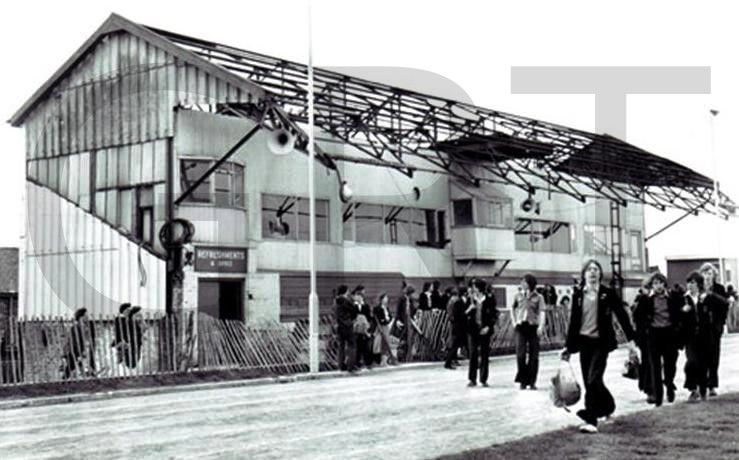Wigan Municipal Stadium, Woodhouse Lane, Wigan, Greater Manchester.
POSTCODE———————————–WN6 7SF
LOCATED————————————-About one and a half miles north west of Wigan’s town centre, and about half a mile north of the present day JJB Football Stadium. Along Woodhouse Lane is a fuel station on its west side, opposite is the access road to the Sandways housing estate, fifty years or so ago this road would have lead you down towards the rear of the stadium’s main stand.
ORIGINAL SITE——————————Land surrounding Woodhouse Farm.
DATE CONSTRUCTED———————1927-28.
DATE VENUE OPENED——————-March 1928.
Meaning other sports may have taken place prior to the arrival of Greyhound Racing.
FIRST MEETING—————————-March 17th 1928.
Greyhound Racing only.
LICENSED OR INDEPENDENT———-Independent
All venues covered would have to be licensed with the government, licensed suggested in this section would refer to tracks operating under NGRC Rules.
INSIDE OR OUTSIDE HARE TYPE——Inside Sumner.
Please note that the Electric Hare suggested is only a guidance and would have been in operation for a certain amount of time at this venue. Although it is not necessarily guaranteed that it was operational all the time, as other types of lure may have been used and updated as time progressed.
DISTANCES———————————–320, 500, 545 and 780 yards.
Please note that most racing venues distances had become varied throughout the years, the ones given above were at once point set and offers only a guidance to the track size.
CIRCUMFERENCE————————–Don’t know.
Please note that alterations at most racing venues throughout its existence would see that the circumference of the track would vary, the one shown above offers only a guidance to the track size.
BIG RACE NAMES————————–None known of.
STADIUM SHARED WITH—————–Speedway team Wigan Panthers, Stock Car Racing and School Sportsdays Events.
LAST MEETING——————————April 1961.
Greyhound Racing only.
STADIUM CLOSURE DATE—————During 1970’s after it was mainly used for school sporting events.
Meaning other sports may have taken place after Greyhound Racing had ceased.
STADIUM DEMOLITION——————-Late 1970’s.
BUILT ON SITE——————————–Housing built on Sandway Housing Estate.
In some cases, structure’s that originally covered the venue after the stadium had been demolished, may have been themselves demolished too, so the one described is more likely to be the one which now presently covers the site.
EVIDENCE LEFT TODAY——————-Nothing known of.
FURTHER COMMENTS——————–None








The Lancashire town of Wigan becomes another addition to the list of towns that hosted greyhound racing at two different venues. Although it is over forty years since Wigan last hosted the dogs, albeit at the Poolstock Stadium, a venue located nearer the town centre, yet it is in this section that describes Wigan’s first track that of the Woodhouse Lane Greyhound Stadium.
The greyhound stadium had been purposely built, and had developed on farmland once occupied by the Woodhouse Farm situated close to Springfield Park, a once active football league ground found one and a half miles Northwest of Wigan’s town centre. Both the greyhound track and Springfield Park were owned by the same company, with the latter being a multi-purpose sporting venue that was at the time the home to Wigan Borough Football Club, and also harness racing.
Woodhouse Lane would open up as a flapping track, and staged its first meeting on the 17th of March 1928, with all the greyhounds on the card being supplied by the greyhound company. In 1932 the greyhound company found themselves in financial trouble due to the folding up of the football club, who in turn left behind massive debts, a position which forced the company to put Springfield Park up for sale. Springfield Park was sold to the newly formed Wigan Athletic Football Club for £2,800, with a clause in the deal stating that the venue must not be used for greyhound racing.
Events at Woodhouse Lane consisted of five dogs racing over distances of 315, 325, 500, 545 and 780 yards, with the hounds chasing an inside Sumner type hare. The tracks kennels were located in a neighbouring field, but a serious fire during October 1953, claimed the lives of seven greyhounds that were housed there.
The stadium played host to another sport, that of speedway racing who staged their first meeting in May 1952, with the Wigan Panthers hosting challenge matches. Some of the speedway’s attendances topped the 10,000 mark, yet within two years The Panthers had disbanded after a number of disputes with the track’s owners, regarding the payments for safety fences, track lighting and a starting gate. School sports events and also stock cars featured there too, but their spells also became brief, with the stock cars creating more damage in one meeting than the speedway riders did in the whole of one year.
The introduction of new betting legislation in 1961 had seen attendances fall drastically at race meetings, which may have contributed to the tracks closure in April 1961. By 1970 the stadium had drifted into a state of disrepair, which saw part of the stadium demolished. The main stand remained but the council-built athletics track on top of were the greyhound track once lay and renamed the venue The Wigan Municipal Stadium. It was used mainly to host school sports events, but eventually the venue became sold for redevelopment during the late 1970’s.
Nothing remains of the stadium today, as the site is covered by new housing found on the Sandway Estate. The positioning of the old stadium’s entrance would be best described as opposite a fuel station on Woodhouse Lane, which lies about half a mile north of Wigan athletics modern JJB Stadium.
A programme, photograph or even memorabilia for this track is required for this page, if you can help please contact me.

Recent Comments